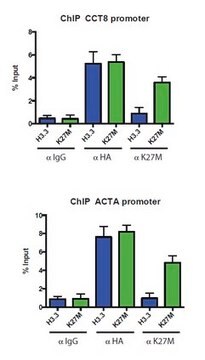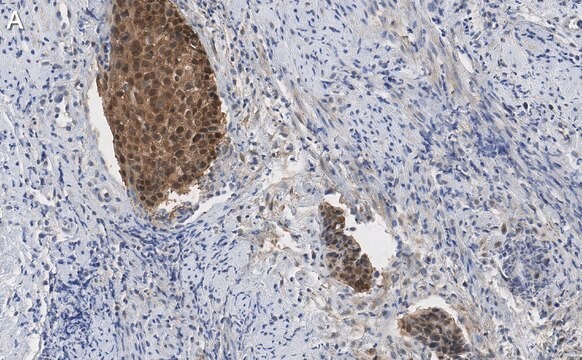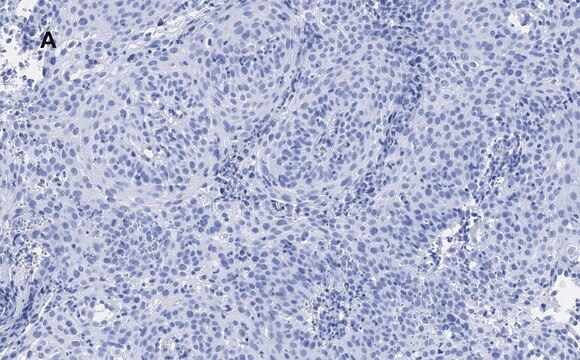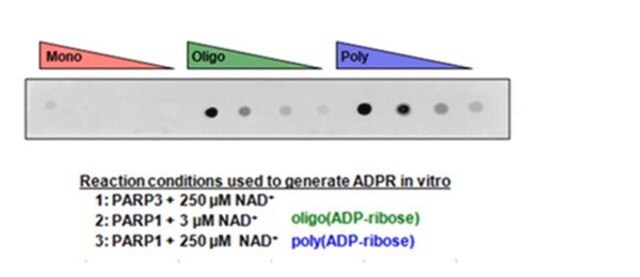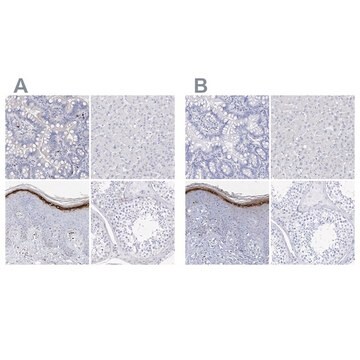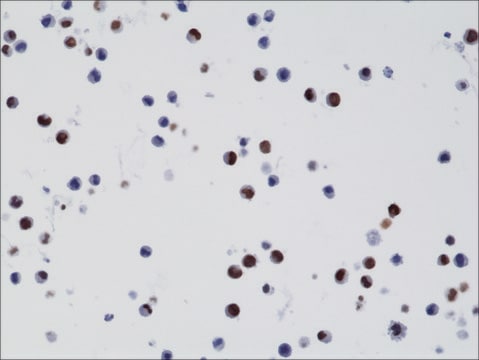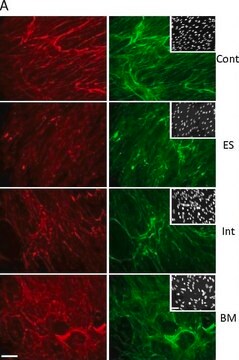一般說明
We are committed to bringing you greener alternative products, which adhere to one or more of The 12 Principles of Green Chemistry.This antibody is Preservative-free, produced without the harm or sacrifice of animals and exceptionally stable to allow for ambient shipping and storage if needed and thus aligns with "Waste Prevention", "Designing Safer Chemicals" and "Design for Energy Efficiency".
Click here for more information.
ZooMAb antibodies represent an entirely new generation of recombinant monoclonal antibodies.
Each ZooMAb antibody is manufactured using our proprietary recombinant expression system, purified to homogeneity, and precisely dispensed to produce robust and highly reproducible lot-to-lot consistency. Only top-performing clones are released for use by researchers. Each antibody is validated for high specificity and affinity across multiple applications, including its most commonly used application. ZooMAb antibodies are reliably available and ready to ship when you need them.
Learn more about ZooMAb here.特異性
Clone 2L10 is a ZooMAb rabbit recombinant monoclonal antibody that specifically detects human Histone H3.3 with G34R mutation.
免疫原
KLH-conjugated linear peptide corresponding to 8 amino acids from the N-terminal region of human Histone H3.3 with G34R mutation.
應用
Anti-Histone H3.3 G34R, clone 2L10 ZooMAb, Cat. No. ZRB1438, is a recombinant Rabbit Monoclonal antibody that targets G34R mutated Histone H3.3 and is tested in Affinity Binding Assay, Immunocytochemistry, and Western Blotting.
Immunocytochemistry Analysis: A 1:100 dilution from a representative lot detected Histone H3.3 G34R in HEK 293T WT and G34R transfected cell lines.
Affinity Binding Assay: A representative lot of this antibody bound Histone H3.3 G34R peptide with a KD of 1.1 x 10-6 in an affinity binding assay.
Note: Actual optimal working dilutions must be determined by end user as specimens, and experimental conditions may vary with the end user
標靶描述
Histone H3.3 (UniProt: P84243) is encoded by the H3F3A (also known as H3.3A, H3F3, PP781, H3F3B, H3.3B) gene (Gene ID: 3020) in human. It is a highly conserved variant form of Histone H3, which replaces conventional H3 in a wide range of nucleosomes in active genes. Histone H 3.3 constitutes the predominant form of histone H3 in non-dividing cells and is incorporated into chromatin independently of DNA synthesis. H3.3 is associated with actively expressed genes in both animals and plants. It is predominantly enriched near transcription end sites (TES) of genes and positively associated with transcription. Histone H3 contains a main globular domain and a long N-terminal tail and is involved with the structure of the nucleosomes of the ′beads on a string′ structure. The N-terminal tail of histone H3 protrudes from the globular nucleosome core and can undergo several different types of epigenetic modifications that influence cellular processes. These modifications include the covalent attachment of methyl or acetyl groups to lysine and arginine amino acids and the phosphorylation of serine or threonine. For example, acetylation on Lys10 (H3K9ac; initial methionine removed) impairs methylation at Arg9 (H3R8me2s) and acetylation on Lys19 (H3K18ac) and Lys24 (H3K24ac) favors methylation at Arg18 (H3R17me). Phosphorylation at Ser11 (H3S10ph) by Aurora kinase B is crucial for chromosome condensation and cell-cycle progression during mitosis and meiosis. Phosphorylation at Ser11 by RPS6KA4 and RPS6KA5 is important during interphase because it enables the transcription of genes following external stimulation, like mitogens, stress, growth factors or UV irradiation and result in the activation of genes, such as c-Fos and c-Jun. Mutations in Histone H3.3 have been implicated in a high proportion of malignant pediatric brain cancers. The mutant H3.3 histone disrupts epigenetic post-translational modifications near genes involved in cancer processes and in brain function. In tumor cells, H3.3K27M and H3.3G34R/V mutations are heterozygously expressed, with one allele of H3F3A being wildtype. K27M and G34R/V mutations are mutually exclusive in tumors and display distinct gene expression profiles and DNA methylation patterns. Almost all tumors bearing G34R/V mutations also exhibit mutations in ATRX/DAXX and display alternate lengthening of telomeres, which is a classical phenotype of cancerous cells. (Ref.: Yuen, BT., and Knoepfler PS (2013). Cancer cell 24(5); 567-74). This ZooMAb® recombinant monoclonal antibody, generated by our propriety technology, offers significantly enhanced specificity, affinity, reproducibility, and stability over conventional monoclonals.
外觀
Purified recombinant rabbit monoclonal antibody IgG, lyophilized in PBS with 5% Trehalose, normal appearance a coarse or translucent resin. Contains no biocide or preservatives, such as azide, or any animal by-products. Larger pack sizes provided as multiples of 25 μL.
重構
0.03 mg/mL after reconstitution at 25μL per vial. Please refer to guidance on suggested starting dilutions and/or titers per application and sample type.
儲存和穩定性
Recommended storage of lyophilized product at 2-8°C; Before reconstitution, micro-centrifuge vials briefly to spin down material to bottom of the vial; Reconstitute each vial by adding 25 μL of filtered lab grade water or PBS; Reconstituted antibodies can be stored at 2-8°C, or -20°C for long term storage. Avoid repeated freeze-thaws.
法律資訊
ZooMAb is a registered trademark of Merck KGaA, Darmstadt, Germany
免責聲明
Unless otherwise stated in our catalog or other company documentation accompanying the product(s), our products are intended for research use only and are not to be used for any other purpose, which includes but is not limited to, unauthorized commercial uses, in vitro diagnostic uses, ex vivo or in vivo therapeutic uses or any type of consumption or application to humans or animals.

